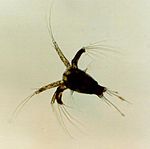Antenna (biology)

Antennae (sg.: antenna), sometimes referred to as "feelers", are paired
Antennae are connected to the first one or two
Crustaceans

The subdivisions of crustacean antennae have many names, including flagellomeres (a shared term with insects), annuli, articles, and segments. The terminal ends of crustacean antennae have two major categorizations: segmented and flagellate. An antenna is considered segmented if each of the annuli is separate from those around it and has individual muscle attachments. Flagellate antennae, on the other hand, have muscle attachments only around the base, acting as a hinge for the flagellum—a flexible string of annuli with no muscle attachment.[5]
There are several notable non-sensory uses of antennae in crustaceans. Many crustaceans have a mobile
| Copepoda | Isopoda | Amphipoda | Decapoda | Decapoda | Remipedia | Cirrepedia | |
|---|---|---|---|---|---|---|---|

|

|

|

|
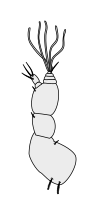
|

|
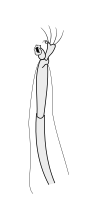
| |

|

|

|
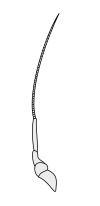
|
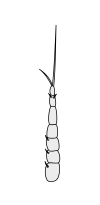
|
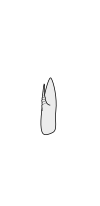
|
Insects

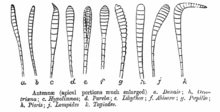
Some claim insects evolved from prehistoric crustaceans, and they have secondary antennae like crustaceans, but not primary antennae. Antennae are the primary
All insects have antennae, however they may be greatly reduced in the larval forms. Amongst the non-insect classes of the
Antennal fibrillae play an important role in Culex pipiens mating practices. The erection of these fibrillae is considered to be the first stage in reproduction. These fibrillae serve different functions across the sexes. As antennal fibrillae are used by female C. pipiens to locate hosts to feed on, male C. pipiens utilize them to locate female mates.[citation needed]
Structure

The three basic segments of the typical insect antenna are the scape or scapus (base), the pedicel or pedicellus (stem), and finally the flagellum, which often comprises many units known as flagellomeres.[10] The pedicel (the second segment) contains the Johnston's organ which is a collection of sensory cells.[11]
The scape is mounted in a socket in a more or less ring-shaped sclerotised region called the torulus, often a raised portion of the insect's head capsule. The socket is closed off by the membrane into which the base of the scape is set. However, the antenna does not hang free on the membrane, but pivots on a rigidly sprung projection from the rim of the torulus. That projection on which the antenna pivots is called the antennifer. The whole structure enables the insect to move the antenna as a whole by applying internal muscles connected to the scape. The pedicel is flexibly connected to the distal end of the scape and its movements in turn can be controlled by muscular connections between the scape and pedicel. The number of flagellomeres can vary greatly between insect species, and often is of diagnostic importance.[citation needed]
True flagellomeres are connected by membranous linkage that permits movement, though the flagellum of "true" insects does not have any intrinsic muscles. Some other Arthropoda do however have intrinsic muscles throughout the flagellum. Such groups include the Symphyla, Collembola and Diplura. In many true insects, especially the more primitive groups such as Thysanura and Blattodea, the flagellum partly or entirely consists of a flexibly connected string of small ring-shaped annuli. The annuli are not true flagellomeres, and in a given insect species the number of annuli generally is not as consistent as the number of flagellomeres in most species.[10]
In many
Quite commonly the funicle beyond the pedicel is quite complex in
Because the funicle is without intrinsic muscles, it generally must move as a unit, in spite of being articulated. However, some funicles are complex and very mobile. For example, the Scarabaeidae have lamellate antennae that can be folded tightly for safety or spread openly for detecting odours or pheromones. The insect manages such actions by changes in blood pressure, by which it exploits elasticity in walls and membranes in the funicles, which are in effect erectile.[12]
In the groups with more uniform antennae (for example:
Functions
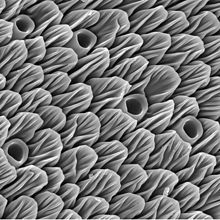
In the
In the African cotton leafworm, antennae have an important function in signaling courtship. Specifically, antennae are required for males to answer the female mating call. Although females do not require antennae for mating, a mating that resulted from a female without antennae was abnormal.[16]
In the diamondback moth, antennae serve to gather information about a host plant's taste and odor. After the desired taste and odor has been identified, the female moth will deposit her eggs onto the plant.[17] Giant swallowtail butterflies also rely on antenna sensitivity to volatile compounds to identify host plants. It was found that females are actually more responsive with their antenna sensing, most likely because they are responsible for oviposition on the correct plant.[18]
In the crepuscular hawk moth (Manduca sexta), antennae aid in flight stabilization. Similar to halteres in Dipteran insects, the antennae transmit coriolis forces through the Johnston's organ that can then be used for corrective behavior. A series of low-light, flight stability studies in which moths with flagellae amputated near the pedicel showed significantly decreased flight stability over those with intact antennae.[19] To determine whether there may be other antennal sensory inputs, a second group of moths had their antennae amputated and then re-attached, before being tested in the same stability study. These moths showed slightly decreased performance from intact moths, indicating there are possibly other sensory inputs used in flight stabilization. Re-amputation of the antennae caused a drastic decrease in flight stability to match that of the first amputated group.[citation needed]
References
- ISBN 978-0521570480.
- ^ .
- ISBN 978-94-011-4904-4.
- S2CID 54841296.
- S2CID 25339728.
- ^ Exceptional preservation of mid-Cretaceous marine arthropods and the evolution of novel forms via heterochrony - NCBI
- OCLC 1391997.
- ISBN 978-1-4051-1113-3.
- ISBN 978-0-521-57890-5.
- ^ ISBN 978-3-540-65034-8.
- ^ The Insects: An Outline of Entomology, Fourth Edition
- ISBN 978-0-13-127384-9.
- Georg-August-Universität Göttingen. Retrieved March 27, 2010.
- PMID 19779201.
- S2CID 53188823.
- S2CID 28455636.
- ISSN 0090-0222.)
{{cite journal}}: CS1 maint: multiple names: authors list (link - S2CID 2429129.





